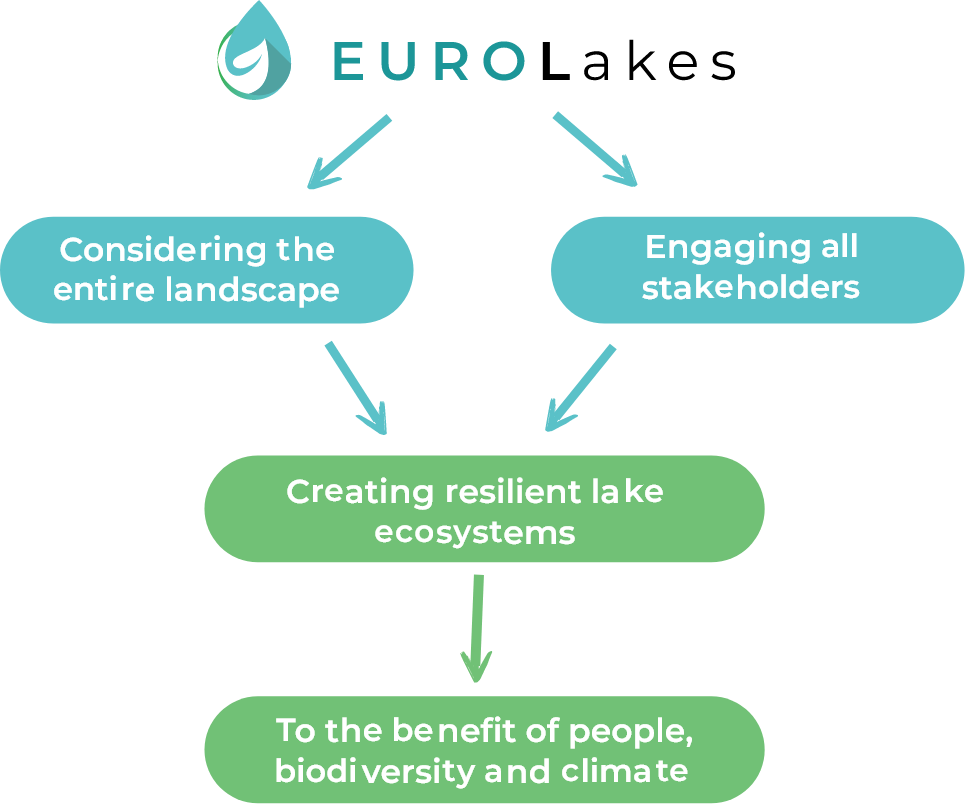Overview
Human activity, from local practices to large-scale basin management, are putting significant pressure on the ecological health of European lakes, thus negatively impacting the environment through water over-extraction, pollution, nutrient overload (eutrophication) and disruptions to the natural flow and structure of lakes (hydro-morphological changes). While climate change is intensifying these stresses, healthy lake ecosystems can help people and nature become more resilient to climate shocks.
Despite their importance, many lake management and restoration efforts are fragmented, often overlooking the larger, basin-wide landscape, the interconnections between land and water, and the diverse needs of neighborhoods who depend on these ecosystems.
Many restoration projects are small, short-term, and focused on specific sectors, which leads to disengaged local communities – a disconnection resulting in what the 4 Returns Framework for landscape restoration (4RF) calls “the 4 losses”.
EUROLakes project aims to address these challenges with an innovative, science-driven, and holistic strategy for protecting and restoring Europe’s natural lakes. [By considering the entire landscape and engaging all stakeholders, the project seeks to create resilient lake ecosystems that benefit people, biodiversity, and the climate.]

The Objectives of EUROLakes
each objective addresses specific challenges
Addressed Challenges – To restore lakes and their ecosystems with a community-led approach that integrates land and water solutions. Actively involvement of stakeholders along the process with establishing enduring "living labs" for long-term site management.
Addressed Challenges – To demonstrate the effectiveness of protection and restoration (P&R) measures at the landscape level with tailored actions addressing each lake's primary challenges. Provide integrated solutions, such as reducing agricultural runoff with nature-based strategies, promoting sustainable land use, monitoring ecosystem health, improving species conservation, mitigating human impact, and embedding results into management plans while strengthening environmental monitoring and community engagement.
Addressed Challenges – To achieve a successful socio-economic transition for restored lake ecosystems, it's essential to address the implementation challenges faced by communities with enhanced understanding of ecosystem services and financing opportunities. Develop comprehensive training programs that integrate ecological, economic, and social data, fostering awareness and capacity-building among diverse stakeholders to effectively valuate and finance lake restoration efforts.
Addressed Challenges – Water scarcity, pollution, and biodiversity loss in lakes can be effectively addressed using advanced modeling techniques to assess the impact of climate change and human activities, identify key stressors, and design targeted protection and restoration (P&R) measures. A comprehensive modeling toolbox is essential to test and monitor these measures under various changing conditions, ensuring they are scalable, effective, and adaptable to diverse locations.
Addressed Challenges – Given the interconnected nature of the water bodies in Europe, an effective lake conservation and restoration effort requires cross-border cooperation, stakeholder engagement, and the sharing of best practices. Coordinated endeavor can overcome challenges like disparities in scientific expertise and varying communication channels by using standardized monitoring methods and a central platform for knowledge exchange. Outreach campaigns and collaboration across sectors are essential to scale successful solutions and ensure broad stakeholder involvement.
Addressed Challenges – The European Green Deal's success hinges on effective implementation. Connecting protection and restoration (P&R) measures with policies, tools, and financing at all levels is crucial for scaling up best practices, while an innovative framework is needed to showcase integrated actions that meet multiple policy goals.



Expected Results
Project methodology aligned with the 4 Returns Framework (4RF)
A multi-stakeholder platform facilitating an Integrated participatory community-based approach for sharing insights and long-term management of each lake.
Local communities of practice – well-informed, actively engaged and empowered to participate in the decision-making process regarding their lakes.
Actionable P&R strategies – context-specific and stakeholder informed, accounting for ecological health, cultural significance, economic viability and social well-being.
Adaptable implementation plans, guiding the restoration while allowing for continuous optimization, driven by data and stakeholders’ feedback.
A comprehensive economic valuation of the ecosystem services provided to society and to nature at the lake demo sites.
A set of financing opportunities to support lake ecosystem restoration at landscape scale.
Training materials for economic transition, to include the role of green finance and private investment to support lake restoration activities at landscape level.
Action plans and roadmaps on the implemented solutions to support organizations in developing replication projects in other regions.
Policy recommendations to support enhanced policy implementation for lake landscapes as means of achieving multi-benefit Green Deal objectives.
Localized demonstrative P&R measures and NBS to address the local and regional challenges found in the three case studies.
An open source data modelling framework including water quantity, water quality, biodiversity and economics.
Digital twins platform to develop and test management strategies for improved water quality & biodiversity, and predict the impact of changes to the water body.
Data management guidelines, procedures and controls

